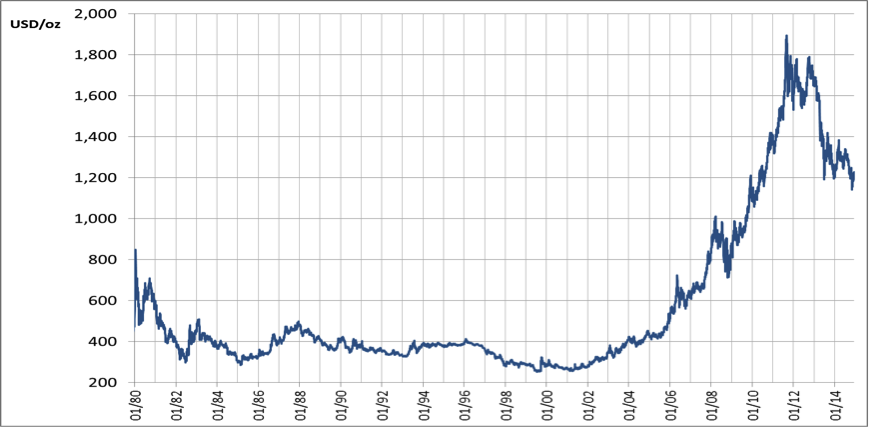
Gold ended 2014 almost exactly where it began -the price on the year’s final day of trading settled at $1184.10 an ounce, having started the year at $1205. Save for some notable weakness in the final quarter, 2014 was a year of relative market stability with fairly range-bound pricing, particularly when compared with the near-$500 crash experienced in 2013.
From a historical point of view, however, gold still remains high:

Nominal gold price (USD/ounce), 1980 – 2014 (Source: World Gold Council)
Bull Run
From the early 1980s to 2001, gold prices remained comparatively sedate. They then accelerated upwards, embarking on a bull run which peaked in 2011 above $1900, and which finally ended in 2012.
The boom in gold and other commodities was partially sparked by the rise of China and India as economic powerhouses. Asian central banks and Russia began buying substantial amounts of gold, providing the market with a shot in the arm.
Between late 2005 and 2008, the dollar experienced sustained weakness, losing more than 40 cents against the euro. As dollar-denominated gold therefore became cheaper and more attractive for global investors, higher demand pushed gold prices up further.
Gold did experience somewhat of a price correction when all financial markets fell during the ‘credit crunch’ in 2008, dropping from over $1200 down to $1000. However, beginning in 2009, continued dollar weakness, various European sovereign debt crises and potential accelerating inflation all became important factors to consider, with each factor persuading investors that gold was a ‘safe haven’ – a low-risk investment to maintain the value of one’s wealth, further boosting the price.
Exacerbating the upward trend was the introduction in 2004 of GLD, the ticker symbol for The SPDR Gold Trust exchange-traded fund. GLD, sponsored by the World Gold Council, was intended to improve liquidity in the market, and it provided an easy way for investors to gain exposure to gold without actually owning the physical metal and having to deal with its associated logistical issues.
GLD holds gold bars and issues shares which are backed by holdings of physical metal. One of the fastest-growing funds ever, it became the second-largest equity holding by 2012, although positions have been liquidated by many since then as gold price has fallen.
Price Crash
2013 convincingly saw the end of gold’s 12-year bull run, with the price dropping by 28% over the year. Investors liquidated positions in gold and moved into equities. The return of investor risk appetite for equities is often a sign of sustained economic stability, and a series of strong US economic data throughout 2013 certainly supported this market view.
Arguably more influential to gold’s drop, however, was the expectation of a reduction in the Federal Reserve’s financial stimulus package. Although the reduction of $10bn to $75bn per month was eventually announced in December 2013, expectations of this measure being introduced persisted throughout the year, meaning that the requirement to invest in gold as a hedge against inflation was somewhat mitigated.
High Mining Costs
The price decline from all-time highs has hurt certain producers who have been saddled with liabilities on projects agreed upon during the bull run, when costs were allowed to spiral upwards on the assumption of a new high-price environment for gold. The mining industry has taken more than $26bn of write-downs after prices declined in 2013.
The world’s biggest producer, Barrick Gold, is a prime example. Ballooning costs saw Barrick make a $5bn write-down on its Pascua-Lama mine in South America in 2013, while in the last few weeks it has suspended operations at its Zambian mine due to a recent increase in the country’s mining royalty rate from 6% to 20%. Despite showing strong operational results in 2014’s third quarter and conducting a major overhaul at board and management level in the last year, Barrick saw its stock fall in October to its lowest level in more than two decades while still facing high debt levels.
Market Outlook
The long-term consensus is generally neutral to bearish. Goldman Sachs, for example, has set its forecast for the next three years at $1200, similar to today’s level, because it estimates that this is the new break-even price for the mining industry after all costs are taken into account.
World Gold Council figures show year-on-year world gold demand falling by 6% in the third quarter. China’s economic growth and gold demand are predicted to keep slowing down, as in 2014. India’s demand, however, has been buoyed by its decision to scrap limits on gold imports and has, in fact, moved ahead of China to become the world’s top gold consumer. The demand from both countries comprises 54% of the world’s total.
The US economy is also expected to remain strong throughout 2015. This may very well inspire a continued investor exit from gold and GLD into equities. The end of the Fed’s 5-year quantitative easing program in October, the expected strong dollar, and low inflation are all signs of stable US financial health – and also traditionally bearish signs for gold.

